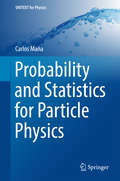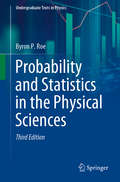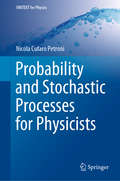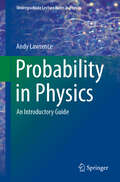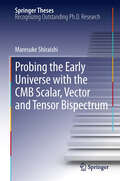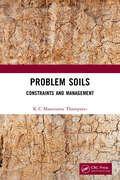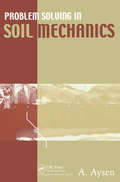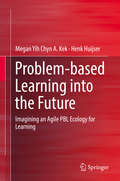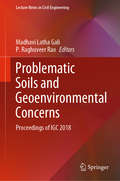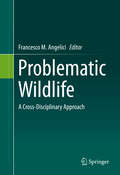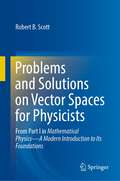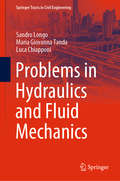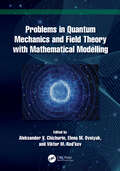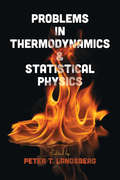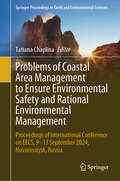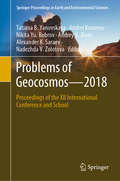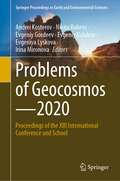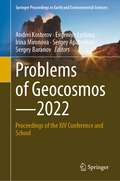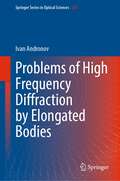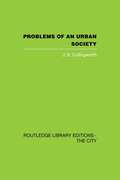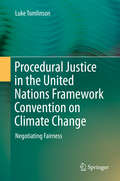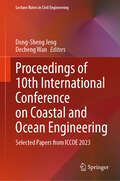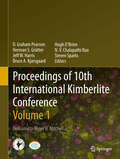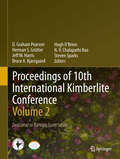- Table View
- List View
Probability and Statistics for Particle Physics
by Carlos MañaThis book comprehensively presents the basic concepts of probability and Bayesian inference with sufficient generality to make them applicable to current problems in scientific research. The first chapter provides the fundamentals of probability theory that are essential for the analysis of random phenomena. The second chapter includes a full and pragmatic review of the Bayesian methods that constitute a natural and coherent framework with enough freedom to analyze all the information available from experimental data in a conceptually simple manner. The third chapter presents the basic Monte Carlo techniques used in scientific research, allowing a large variety of problems to be handled difficult to tackle by other procedures. The author also introduces a basic algorithm, which enables readers to simulate samples from simple distribution, and describes useful cases for researchers in particle physics.The final chapter is devoted to the basic ideas of Information Theory, which are important in the Bayesian methodology. This highly readable book is appropriate for graduate-level courses, while at the same time being useful for scientific researches in general and for physicists in particular since most of the examples are from the field of Particle Physics.
Probability and Statistics in the Physical Sciences (Undergraduate Texts in Physics)
by Byron P. RoeThis book, now in its third edition, offers a practical guide to the use of probability and statistics in experimental physics that is of value for both advanced undergraduates and graduate students. Focusing on applications and theorems and techniques actually used in experimental research, it includes worked problems with solutions, as well as homework exercises to aid understanding. Suitable for readers with no prior knowledge of statistical techniques, the book comprehensively discusses the topic and features a number of interesting and amusing applications that are often neglected. Providing an introduction to neural net techniques that encompasses deep learning, adversarial neural networks, and boosted decision trees, this new edition includes updated chapters with, for example, additions relating to generating and characteristic functions, Bayes’ theorem, the Feldman-Cousins method, Lagrange multipliers for constraints, estimation of likelihood ratios, and unfolding problems.
Probability and Stochastic Processes for Physicists (UNITEXT for Physics)
by Nicola Cufaro PetroniThis book seeks to bridge the gap between the parlance, the models, and even the notations used by physicists and those used by mathematicians when it comes to the topic of probability and stochastic processes. The opening four chapters elucidate the basic concepts of probability, including probability spaces and measures, random variables, and limit theorems. Here, the focus is mainly on models and ideas rather than the mathematical tools. The discussion of limit theorems serves as a gateway to extensive coverage of the theory of stochastic processes, including, for example, stationarity and ergodicity, Poisson and Wiener processes and their trajectories, other Markov processes, jump-diffusion processes, stochastic calculus, and stochastic differential equations. All these conceptual tools then converge in a dynamical theory of Brownian motion that compares the Einstein–Smoluchowski and Ornstein–Uhlenbeck approaches, highlighting the most important ideas that finally led to a connection between the Schrödinger equation and diffusion processes along the lines of Nelson’s stochastic mechanics. A series of appendices cover particular details and calculations, and offer concise treatments of particular thought-provoking topics.
Probability in Physics: An Introductory Guide (Undergraduate Lecture Notes in Physics)
by Andy LawrenceThis textbook presents an introduction to the use of probability in physics, treating introductory ideas of both statistical physics and of statistical inference, as well the importance of probability in information theory, quantum mechanics, and stochastic processes, in a unified manner. The book also presents a harmonised view of frequentist and Bayesian approaches to inference, emphasising their complementary value. The aim is to steer a middle course between the "cookbook" style and an overly dry mathematical statistics style. The treatment is driven by real physics examples throughout, but developed with a level of mathematical clarity and rigour appropriate to mid-career physics undergraduates. Exercises and solutions are included.
Probing the Early Universe with the CMB Scalar, Vector and Tensor Bispectrum
by Maresuke ShiraishiThe non-Gaussianity in the primordial density fluctuations is a key feature to clarify the early Universe and it has been probed with the Cosmic Microwave Background (CMB) bispectrum. In recent years, we have treated the novel-type CMB bispectra, which originate from the vector- and tensor-mode perturbations and include the violation of the rotational or parity invariance. On the basis of our current works, this thesis provides the general formalism for the CMB bispectrum sourced by the non-Gaussianity in the scalar, vector and tensor-mode perturbations. Applying this formalism, we calculate the CMB bispectra from the two scalars and a graviton correlation and primordial magnetic fields, and then outline new constraints on these magnitudes. Furthermore, this formalism can be easily extended to the cases where the rotational or parity invariance is broken. We also compute the CMB bispectra from the scalar-mode non-Gaussianities with a preferred direction and the tensor-mode non-Gaussianities induced by the parity-violating Weyl cubic terms. Here, we show that these bispectra include unique signals, which any symmetry-invariant models can never produce.
Problem Soils: Constraints and Management
by K C ThampattiThis is a unique book that deals with the problem soils, their constraints and management in the Indian context. The book starts with the introduction on problem soils and the classification of these soils are included there under. In India, there is wide spread occurrence of soils with different types of constraints for crop production. Such soils are popularly called as “Problem Soils”. Cultivation in these soils is not so easy as several problems have to be tackled during cultivation. It may be either soil droughtiness or acidity or salinity etc. An attempt has been made in this book to cover most of the problematic soils in India. The classification of problem soils has been done based on the limitations they possess and the most dominant limitation is taken into consideration for grouping it under a particular class. Here five broader classes have been identified viz., soils with climatic problems; soils with physical problems; soils with chemical problems; soils with biological problems and soils with problems due to anthropogenic reasons.
Problem Solving in Soil Mechanics
by A. AysenWritten for university students taking first-degree courses in civil engineering, environmental and agricultural engineering, Problem Solving in Soil Mechanics stimulates problem-solving learning as well as facilitating self-teaching. Generally assuming prior knowledge of subject, necessary basic information is included to make it accessible to readers new to the topic. Filled with worked examples, new and advanced topics and with a flexible structure that means it can be adapted for use in second, third and fourth year undergraduate courses in soil mechanics, this book is also a valuable resource for the practising professional engineer as well as undergraduate and postgraduate students. Primarily designed as a supplement to Soil Mechanics: Basic Concepts and Engineering Applications, this book can be used by students as an independent problem-solving text, since there are no specific references to any equations or figures in the main book.
Problem-based Learning into the Future
by Henk Huijser Megan Yih Chyn A. KekIn this book we respond to a higher education environment that is on the verge of profound changes by imagining an evolving and agile problem-based learning ecology for learning. The goal of doing so is to humanise university education by pursuing innovative approaches to student learning, teaching, curricula, assessment, and professional learning, and to employ interdisciplinary methods that go far beyond institutional walls and include student development and support, curriculum sustainability, research and the scholarship of teaching and learning, as well as administration and leadership. An agile problem-based learning (PBL) ecology for learning deliberately blurs the boundaries between disciplines, between students and teachers, between students and employers, between employers and teachers, between academics and professional staff, between formal and informal learning, and between teaching and research. It is based on the recognition that all of these elements are interconnected and constantly evolving, rather than being discrete and static. Throughout this book, our central argument is that there is no single person who is responsible for educating students. Rather, it is everyone's responsibility - teachers, students, employers, administrators, and wider social networks, inside and outside of the university. Agile PBL is about making connections, rather than erecting barriers. In summary, this book is not about maintaining comfort zones, but rather about becoming comfortable with discomfort. The actual implementation is beyond the scope of this book and we envisage that changing perceptions towards this vision will itself be a mammoth task. However, we believe that the alternative of leaving things as they are would ultimately prove untenable, and more distressingly, would leave a generation of students afraid to think, feel, and act for themselves, let alone being able to face the challenges of the 21st century.
Problematic Soils and Geoenvironmental Concerns: Proceedings of IGC 2018 (Lecture Notes in Civil Engineering #88)
by Madhavi Latha Gali P. Raghuveer RaoThis volume comprises select papers presented during the Indian Geotechnical Conference 2018. This volume focuses on discussing the many challenges encountered in geoenvironmental engineering. The book covers sustainability aspects related to geotechnical engineering, problematic soils and ground improvement, use of geosynthetics and concepts of soil dynamics. The contents of this book will be useful to researchers and professionals working in geo-environmental engineering and to policy makers interested in understanding geotechnical concerns related to sustainable development.
Problematic Wildlife
by Francesco M. AngeliciThis book provides insight into the instancesin which wildlife species can create problems. Some species trigger problemsfor human activities, but many others need humans to save them and to continueto exist. The text addresses issues faced by economists and politicians dealingwith laws involving actions undertaken to resolve the problems of theinteraction between humans and wildlife. Here, the words 'problematic species'are used in their broadest sense, as may be appreciated in the short introductionsto the various sections. At times, the authors discuss special cases whilealways extending the discussion into a more general and broad vision. At others,they present real cutting-edge analysis of ecological topics and issues. The book will be of interest to biologists,ecologists and wildlife managers involved in research on wildlife, parks, andenvironmental management, as well as to government departments and agencies,NGOs and conservation wildlife organizations. Even those in contact with nature,such as hunters, herders, and farmers, will be able to find a great deal ofimportant information. Specific case studies are selected from among the mostsignificant and prevalent cases throughout the world. A total of 26 papers have been selected forthis book, written by zoologists, biologists and ecologists. Many have aninterdisciplinary approach, with contributions by economists, criminologists, technicalspecialists, and engineers.
Problematic Wildlife II: New Conservation and Management Challenges in the Human-Wildlife Interactions
by Francesco Maria Angelici Lorenzo RossiIn a world where habitats are constantly changing and the impact of anthropization on the environment is increasingly intense, interactions between human and wildlife are becoming more and more complex. Some species pose problems for human activities while many others need to be helped in order to continue to exist. This book follows the first volume called 'Problematic Wildlife', edited by F.M. Angelici and published by Springer in 2016, which has had considerable success with readers and critics. The volume includes 21 chapters divided into 7 parts devoted specific topics which are approached in a multidisciplinary way. There are both review chapters and specific cases, always bearing in mind the interest for an international audience. The book is useful both for scientists, wildlife specialists, conservationists, zoologists, ecologists, university students, nature managers, and for those who live in contact with wildlife and its problems, such as farmers, shepherds, hunters, urban planners, and staff of parks and nature reserves. Its ultimate goal is to offer scientific and pragmatic approaches to manage each categories of problematic species.
Problems and Solutions on Vector Spaces for Physicists: From Part I in Mathematical Physics—A Modern Introduction to Its Foundations
by Robert B. ScottThis book offers supporting material for the comprehensive textbook Mathematical Physics—A Modern Introduction to Its Foundations authored by Sadri Hassani. The book covers mathematical preliminaries and all of Part I in Hassani’s textbook. The subjects covered here include the key topics necessary for physicists to form a solid mathematical foundation: vectors and linear maps, algebras, operators, matrices, and spectral decomposition. In particular, the vector space concept is a central unifying theme in later chapters of Hassani’s textbook. Detailed solutions are provided to one third of the end-of-chapter exercises in the first six chapters of his text. The present volume helps upper-undergraduate and early postgraduate physics students deepen their understanding of the mathematics that they encounter in physics, learn physics more efficiently, and use mathematics with more confidence and creativity. The content is thus presented rigorously but remains accessible to physics students. New exercises are also proposed, some with solutions, some without, so that the total number of unsolved exercises remains unchanged. They are chosen to help explain difficult concepts, amplify key points in Hassani's textbook, or make further connections with applications in physics. Taken together with Hassani's work, the two form a self-contained set and the solutions make detailed reference to Hassani's text. The solutions also refer to other mathematics and physics textbooks, providing entry points to further literature that finds a useful place in the physicist's personal library.
Problems in Hydraulics and Fluid Mechanics (Springer Tracts in Civil Engineering)
by Sandro Longo Maria Giovanna Tanda Luca ChiapponiThis textbook offers a unique introduction to hydraulics and fluid mechanics through more than 100 exercises, with guided solutions, which students will find valuable in preparation for their preliminary or qualifying exams and for testing their grasp of the subject. In some exercises two different solution methods are proposed, to highlight the fact that the level of complexity of the calculations is often linked to the choice of method, though in most cases only the simplest method is presented. The exercises are organized by subject, covering forces on planes and curved surfaces; floating bodies; exercises that require the application of linear and angular momentum balancing in inertial and non-inertial references; pipeline systems, with particular applications to industrial plants; hydraulic systems with machines (pumps and turbines); transient phenomena in pipelines; and uniform and gradually varied flows in open channels. The book also features appendices that contain selected data and formulas of practical interest. Instructors of courses that address one or all of the above topics will find the exercises of great help in preparing their courses, while researchers will find the book useful as an accessible summary of the topics covered.
Problems in Quantum Mechanics and Field Theory with Mathematical Modelling
by Aleksander V. Chichurin Elena M. Ovsiyuk Viktor M. Red’kovIn Problems in Quantum Mechanics and Field Theory with Mathematical Modelling, a number of exactly solvable problems in electrodynamics and in quantum-mechanics of particles with different spins are presented.The main topics covered include: the Cox scalar particle with intrinsic structure in presence of the magnetic field in the spaces of constant curvature, Euclid, Riemann, and Lobachevsky; Cox particle in the Coulomb field; tunneling effect through Schwarzschild barrier for a spin 1/2 particle; electromagnetic field in Schwarzschild space-time, the Majorana - Oppenheimer approach in electrodynamics; scalar particle with polarizability in the Coulomb field; Dirac particle in the Coulomb field on the background of hyperbolic Lobachevsky and spherical Riemann models; particle with spin 1 in the Coulomb field; geometrical modeling of the media in Maxwell electrodynamics; P-asymmetric equation for a spin 1/2 particle; fermion with two mass parameters in the Coulomb field; helicity operator for a spin 2 particle in presence of the magnetic field.The book will be of interest to researchers, and is accessible enough to serve as a self-study resources for courses at undergraduate and graduate levels.
Problems in Thermodynamics and Statistical Physics (Dover Books on Physics)
by Peter T. LandsbergWell respected and widely used, this volume presents problems and full solutions related to a wide range of topics in thermodynamics, statistical physics, and statistical mechanics. The text is intended for instructors, undergraduates, and graduate students of mathematics, physics, chemistry, and engineering. Twenty-eight chapters, each prepared by an expert, proceed from simpler to more difficult subjects. Similarly, the early chapters are easier than the later ones, making the book ideal for independent study.Subjects begin with the laws of thermodynamics and statistical theory of information and of ensembles, advancing to the ideal classical gases of polyatomic molecules, non-electrolyte liquids and solutions, and surfaces. Subsequent chapters explore imperfect classical and quantum gas, phase transitions, cooperative phenomena, Green function methods, the plasma, transport in gases and metals, Nyquist's theorem and its generalizations, stochastic methods, and many other topics.
Problems of Coastal Area Management to Ensure Environmental Safety and Rational Environmental Management: Proceedings of International Conference on EECS, 9-13 September 2024, Novorossiysk, Russia (Springer Proceedings in Earth and Environmental Sciences)
by Tatiana ChaplinaThis book presents the results of basic and applied studies on the solution of burning issues within the analysis of anomalous changes in marine environment under the influence of climatic changes and economic activities in the Azov-Black Sea basins. The collection of articles contains the articles by leading experts and young scientists that are devoted to the problems of monitoring and management of coastal territories of the Sea of Azov, Kerch Strait, and near-strait zones of the Black Sea. This book contains articles on various issues of the Azov-Black Sea basin, including space monitoring of coastal characteristics, investigation of coastline dynamics, study of currents using acoustic Doppler profiling, carbon fluxes and methane sources on the shelf, climate change assessments in the seas, assessments of microplastic compounds in surface waters, interannual variability of sea ice, etc. This book presents a thorough investigation into the pressing issues stemming from abnormal changes in the marine environments of the Azov-Black Sea basins, influenced by climatic fluctuations and human endeavors. It compiles pivotal studies from renowned experts and emerging young scientists dedicated to the challenges of monitoring, managing, and preserving the coastal zones of the Sea of Azov, Kerch Strait, and the adjacent areas of the Black Sea. These contributions span a vast array of subjects, including but not limited to, satellite surveillance of coastal attributes, dynamics of shorelines, analysis of ocean currents through acoustic Doppler profiling, carbon dioxide flows, sources of methane on the continental shelf, evaluations of climate alterations in maritime regions, and the quantification of microplastic contaminants in marine surfaces. With a significant focus on the advancement and application of cutting-edge information technologies, artificial intelligence, and mathematical modeling, this book offers an in-depth exploration of hydrophysical phenomena, hydrodynamics, coastal processes, and issues related to water pollution.
Problems of Geocosmos–2018: Proceedings of the XII International Conference and School (Springer Proceedings in Earth and Environmental Sciences)
by Andrei Kosterov Tatiana B. Yanovskaya Nikita Yu. Bobrov Andrey V. Divin Alexander K. Saraev Nadezhda V. ZolotovaThis book includes the proceedings of the conference “Problems of the Geocosmos” held by the Earth Physics Department, St. Petersburg State University, Russia, every two years since 1996. Covering a broad range of topics in solid Earth physics and solar-terrestrial physics, as well as more applied subjects such as engineering geology and ecology, the book reviews the latest research in planetary geophysics, focusing on the interaction between the Earth’s shells and the near-Earth space in a unified system. This book is divided into four sections: • Exploration and Environmental Geophysics (EG), which covers two broad areas of environmental and engineering geophysics – near-surface research and deep geoelectric studies; • Paleomagnetism and Rock Magnetism (P), which includes research on magnetostratigraphy, paleomagnetism applied to tectonics, environmental magnetism, and marine magnetic anomalies; • Seismology (S), which covers the theory of seismic wave propagation, Earth’s structure from seismic data, global and regional seismicity and sources of earthquakes, and novel seismic instruments and data processing methods; and • Physics of Solar-Terrestrial Connections (STP), which includes magnetospheric phenomena, space weather, and the interrelationship between solar activity and climate.
Problems of Geocosmos–2020: Proceedings of the XIII International Conference and School (Springer Proceedings in Earth and Environmental Sciences)
by Andrei Kosterov Nikita Bobrov Evgeniy Gordeev Evgeniy Kulakov Evgeniya Lyskova Irina MironovaThis book addresses the problems of Geocosmos and provides a snapshot of the current research in a broad area of Earth Sciences carried out in Russia and elsewhere. The themes covered include solar physics, physics of magnetosphere, ionosphere and atmosphere, solar-terrestrial coupling links, seismology, geoelectricity, paleomagnetism and rock magnetism, as well as cross-disciplinary studies. The proceedings are carefully edited, providing a panoramic outlook of a broad area of Earth Sciences. The readership includes colleague researchers, students and early career scientists. The proceedings will help the readers to look at their research fields from various points of view. Problems of Geocosmos conferences are held by Earth Physics Department, St. Petersburg University bi-annually since 1994. It is the largest forum of this kind in Russia/former Soviet Union attracting up to 200 researchers in Earth and magnetospheric physics.
Problems of Geocosmos—2022: Proceedings of the XIV Conference and School (Springer Proceedings in Earth and Environmental Sciences)
by Andrei Kosterov Evgeniya Lyskova Irina Mironova Sergey Apatenkov Sergey BaranovProblems of Geocosmos conference proceedings series provide a snapshot of current research in a broad area of Earth Sciences carried out in Russia and elsewhere. Themes covered include solar physics, physics of magnetosphere, ionosphere and atmosphere, solar-terrestrial coupling links, seismology and geodynamics, paleomagnetism and rock magnetism, as well as cross-disciplinary studies. The proceedings are carefully edited, providing a panoramic outlook of a broad area of Earth Sciences. The readership includes colleague researchers, students and early career scientists. The proceedings will help the readers to look at their research fields from various points of view. Problems of Geocosmos conferences are held by Earth Physics Department, St. Petersburg University bi-annually since 1994. It is one of the largest forums of this kind in Russia/former Soviet Union attracting up to 200 researchers in Earth and magnetospheric physics.
Problems of High Frequency Diffraction by Elongated Bodies (Springer Series in Optical Sciences #243)
by Ivan AndronovClassical asymptotic expansions, while producing a good approximation for the diffracted fields in general, appear hardly applicable in the case of extremely elongated bodies. Thus, there are problems that are on the one hand too difficult for numerical solvers due to large system size, and on the other hand make the description with classical asymptotic methods hard. The book explains why this happens and suggests the way out. By defining the characteristics of a strongly elongated body it introduces a special class of asymptotic approximations, which are in some sense uniform with respect to the rate of body elongation. Chapter 1 briefly describes the results of V. A. Fock and further developments of his approach towards the problems of diffraction by elongated obstacles. It formulates the cases of moderately and strongly elongated bodies. The rest of the book describes the approach of special parabolic equations, which lead to new asymptotic approximations for the diffracted fields. Chapters 2, 3 and 4 discuss diffraction by bodies of elliptical shape: The elliptic cylinder with a strongly elongated cross section and prolate spheroid with a high aspect ratio. Chapter 5 generalizes the approach to some other shapes such as narrow cones and narrow hyperboloids. Mathematical formulas for the Whittaker functions widely used in the book are collected in the Appendix. The concise derivations are supplied with numerous test examples that compare asymptotic approximations with numerically computed fields and clarify the specifics of high frequency diffraction by strongly elongated bodies. The reference solutions presented in the book enable one to validate the newly developed numerical solvers.
Problems of an Urban Society: The Social Framework of Planning
by J.B. CullingworthThis book provides a wide-ranging review of urban problems and constitutes a major contribution to the mounting public debate that these problems are attracting. Many of the problems - of social and economic decay - are not new; indeed they are perennial problems of urban societies. As the complexities and interdependencies of modern life have increased, so has the resolve to combat the environmental and social ills to which these give rise. The particular focus of this volume is on the 'framework' of urban problems - the changing demographic, social and economic structure, the shortage of land and the transport needs of a highly complex industrial society. A mass of facts and figures are neatly and succinctly marshalled to provide a clear picture of the problems. Stress is laid on the essentially political nature of these problems and the alternative solutions. In essence, urban problems are problems of social injustice, of disadvantage and of lack of power. This book was first published in 1973.
Procedural Justice in the United Nations Framework Convention on Climate Change
by Luke TomlinsonThis book considers what is needed for fairness in the decisions of the UNFCCC. It analyses several principles of procedural fairness in order to develop practical policy measures for fair decision-making in the UNFCCC. This includes measures that determine who should have a right to participate in its decisions, how these decisions should take place and what level of equality should exist between these actors. In doing so, it proposes that procedural fairness is a fundamental feature of a multilateral response to address climate change. By showing that procedural fairness is most likely to be achieved through the inclusive process of the UNFCCC, it also shows that global efforts to address climate change should continue in this forum.
Proceedings of 10th International Conference on Coastal and Ocean Engineering: Selected Papers from ICCOE 2023 (Lecture Notes in Civil Engineering #532)
by Dong-Sheng Jeng Decheng WanThis book presents a collection of selected and peer reviewed papers of 10th International Conference on Coastal and Ocean Engineering, which is held during April 14-16, 2023. The conference is co-organized by Taishan University, Shandong, China, technically supported by China University of Petroleum and Concordia University, which aims to bring together innovative academics and industrial experts in the field of coastal and ocean engineering to a common forum. The papers are contributed by various authors from all sectors of academia and industries, exploring cutting-edge solutions and best practices for coastal and ocean engineering. Various topics are discussed in the book, including Coastal infrastructure developments, Hydrodynamics of off shore structures, Marine ecology and environments, Oil spill and environmental hazards, Estuary coastal engineering, Marine energy engineering, underwater engineering, Offshore oil development technology and equipment, the ocean activities platform, etc. The book will serve as a useful reference for post-graduate students, academicians, industry developer and policy makers.
Proceedings of 10th International Kimberlite Conference: Volume One
by Bruce A Kjarsgaard D Graham Pearson Herman S Grütter Hugh O’brien Jeff W Harris N V Rao Steven SparksInternational Kimberlite Conferences (IKCs) are special events that are held across the world once in four to five years. IKC is the confluence platform for academicians, scientists and industrial personnel concerned with diamond exploration and exploitation, petrology, geochemistry, geochronology, geophysics and origin of the primary diamond host rocks and their entrained xenoliths and xenocrysts (including diamond) to get together and deliberate on new advances in research made in the intervening years. Ever since the organization of first IKC in 1973 and its tremendous success, the entire geological world eagerly look forward to subsequent such conferences with great enthusiasm and excitement. The scientific emanations from IKCs continue to make significant impact on our understanding of the composition, nature and evolution of the planet we live on. The previous conferences were held at Cape Town (1973), Santa Fe, New Mexico (1977), Clermont-Ferrand, France, (1982), Perth, Western Australia (1987), Araxa, Brazil (1991), Novosibirsk, Russia (1995), Cape Town (1998), Victoria, Canada (2003) and Frankfurt, Germany (2008). The 10th IKC was held at Bangalore, India between 5th and 11th February 2012. The conference was organized by the Geological Society of India in association with the government organizations, academic institutions and Indian diamond mining companies. About 300 delegates from 36 countries attended the conference and 224 papers were presented. The papers include 78 oral presentations and 146 poster presentations on following topics: Kimberlite geology, origin, evolution and emplacement of kimberlites and related rocks, petrology and geochemistry of metasomatised lithospheric mantle magmas, diamond exploration, cratonic roots, diamonds, diamond mining and sustainable developments and policies and governance of diamond exploration. Pre- and post-conference field trips were organized to (i) the diamond bearing kimberlites of Dharwar Craton in South India, (ii) lamproites of Bundelkhand Craton in northern India and (iii) diamond cutting and polishing industry of Surat, Gujarat in western India. A series of social and cultural programmes depicting cultural diversity of India were organized during the conference. The Kimberlite fraternity enjoyed yet another socially and scientifically successful conference.
Proceedings of 10th International Kimberlite Conference: Volume Two
by Bruce A Kjarsgaard D Graham Pearson Herman S Grütter Hugh O’brien Jeff W Harris N V Rao Steven SparksInternational Kimberlite Conferences (IKCs) are special events that are held across the world once in four to five years. IKC is the confluence platform for academicians, scientists and industrial personnel concerned with diamond exploration and exploitation, petrology, geochemistry, geochronology, geophysics and origin of the primary diamond host rocks and their entrained xenoliths and xenocrysts (including diamond) to get together and deliberate on new advances in research made in the intervening years. Ever since the organization of first IKC in 1973 and its tremendous success, the entire geological world eagerly look forward to subsequent such conferences with great enthusiasm and excitement. The scientific emanations from IKCs continue to make significant impact on our understanding of the composition, nature and evolution of the planet we live on. The previous conferences were held at Cape Town (1973), Santa Fe, New Mexico (1977), Clermont-Ferrand, France, (1982). Perth, Western Australia (1987), Araxa, Brazil (1991), Novosibirsk, Russia (1995), Cape Town (1998), Victoria, Canada (2003) and Frankfurt, Germany (2008). The tenth IKC was held at Bangalore, India between 5th and 11th February 2012. The conference was organized by the Geological Society of India in association with the government organizations, academic institutions and Indian diamond mining companies. About 300 delegates from 36 countries attended the conference and 224 papers were presented. The papers include 78 oral presentations and 146 poster presentations on following topics: Kimberlite geology, origin, evolution and emplacement of kimberlites and related rocks, petrology and geochemistry of metasomatised lithospheric mantle magmas, diamond exploration, cratonic roots, diamonds, diamond mining and sustainable developments and policies and governance of diamond exploration. Pre- and post-conference field trips were organized to (i) the diamond bearing kimberlites of Dharwar Craton in South India, (ii) lamproites of Bundelkhand Craton in northern India and (iii) diamond cutting and polishing industry of Surat, Gujarat in western India. A series of social and cultural programmes depicting cultural diversity of India were organized during the conference. The Kimberlite fraternity enjoyed yet another socially and scientifically successful conference.
